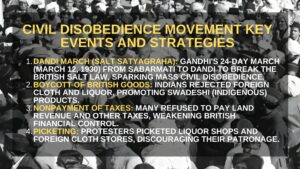The Civil Disobedience Movement was a pivotal phase in India’s struggle for independence, marked by widespread nonviolent resistance against British colonial rule. Initiated by Mahatma Gandhi in 1930, it aimed to attain complete self-rule (Purna Swaraj) by defying unjust laws and regulations imposed by the British government.
Download notes of Home Rule League Movement (1916)
What is Civil Disobedience Movement?
Civil disobedience refers to the active, professed refusal to obey certain laws, demands, or commands of a government, typically as a form of nonviolent resistance. It involves the deliberate violation of laws deemed unjust to bring about social or political change.
In the context of India’s freedom struggle, the Civil Disobedience Movement embodied this principle by challenging colonial authority through peaceful means.
What was the Civil Disobedience Movement?
The Civil Disobedience Movement was a mass protest led by the Indian National Congress under Gandhi’s leadership. It sought to challenge British authority by nonviolently refusing to comply with certain laws, taxes, and regulations.
The movement’s inception was marked by the iconic Dandi March in 1930, where Gandhi and his followers marched approximately 240 miles to the coastal village of Dandi to produce salt from seawater, defying the British salt monopoly.
Civil Disobedience Movement in India
Causes of the Movement
Several factors contributed to the launch of the Civil Disobedience Movement:
-
Economic Exploitation: The colonial policies led to widespread poverty and unemployment among Indians.
-
Simon Commission: The appointment of an all-British commission in 1927 to suggest constitutional reforms, without any Indian representation, was met with nationwide protests.
-
Demand for Purna Swaraj: The failure of the British government to grant dominion status to India led the Congress to declare complete independence as its goal during the Lahore Session in 1929.
Key Events and Strategies
-
Dandi March (Salt Satyagraha): On March 12, 1930, Gandhi commenced a 24-day march from Sabarmati Ashram to Dandi, attracting thousands of followers. Upon reaching the coast, he produced salt, symbolizing the start of mass civil disobedience across the nation.
-
Boycott of British Goods: Indians were urged to boycott foreign cloth and liquor, promoting indigenous products and self-reliance.
-
Nonpayment of Taxes: In certain regions, people refused to pay land revenue and other taxes, directly challenging the economic foundation of British rule.
-
Picketing: Volunteers organized pickets outside liquor shops and foreign cloth stores to dissuade people from patronizing them.

Limitations of the Movement
Despite its widespread impact, the movement faced certain challenges:
-
Communal Tensions: There was an atmosphere of suspicion and distrust between communities, leading to limited participation from certain sections, especially Muslims.
-
Limited Dalit Participation: The movement saw limited involvement from Dalits, particularly in regions like Nagpur, as their specific concerns were not adequately addressed.
-
Internal Divisions: Differences within the Congress, such as between the Responsivists and Non-Responsivists, led to a lack of cohesive strategy.
-
Loss of Momentum: The movement was called off twice, leading to a loss of momentum and creating divisions within the nationalist ranks.
Impact of the Movement
The Civil Disobedience Movement had significant outcomes:
-
Growth of Nationalism: It brought India closer to the goal of complete independence by uniting diverse sections of society in the struggle against colonial rule.
-
Constitutional Reforms: The movement’s pressure led to the enactment of the Government of India Act 1935, introducing provincial autonomy and expanding the electorate.
-
Social Awareness: Issues concerning Dalits and depressed classes received more attention, leading to initiatives aimed at their upliftment.
-
Promotion of Swadeshi: The emphasis on indigenous goods fostered a sense of self-reliance and pride in Indian products.
Download notes of Non Cooperation Movement & Khilafat Movement
The Civil Disobedience Movement, spearheaded by Mahatma Gandhi, was a landmark in India’s quest for freedom. Through nonviolent resistance, it challenged the legitimacy of British rule and mobilized millions in the fight for independence.
Despite facing limitations, the movement significantly advanced the nationalist cause, setting the stage for future struggles and ultimately contributing to India’s independence in 1947.


